It is by far not the only wine route in the good "old wine world". It exists almost everywhere where vines grow, vintners live and offer their wines. But hardly any other wine route is as compact and uniform, as fascinating and original as the almost 170-kilometer-long zigzag course through Alsace. It is a world of its own: "Awer d Elsasser sìn stolz ìwer ìhra Region un gann sìch zwàr Miahj fer ìmmer prima Frànzeesch z'reda", historically torn between Germany and France, full of traditions, many small wine towns and wine villages and more than a hundred wine-growing communities. In the narrow alleys between the half-timbered houses, one often imagines oneself in the Middle Ages, were it not for the stream of tourists that pours over many places like an avalanche and quickly and thoroughly transforms much that would actually be culture or cultural history into a Disneyland. Even Käthe Wohlfahrt, the "Rothenburg Christmas Workshop", has nested here.
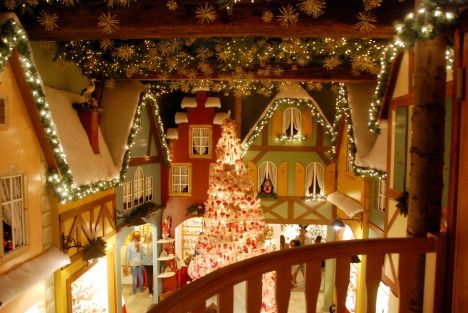
|
| The Christmas World of Käthe Wohlfahrt in Ribeauvillé (Photo: P. Züllig) |
A whole series of villages vie for the honour of being the most beautiful winegrowing village: Obernai, Ottrott, Barr, Andlau, St-Hyppolyte, Bergheim, Ribeauvillé, Riquewihr, Turckheim, Gueberschwihr, Pfaffenheim, Rouffach? Some fight for the glory of having the most beautiful church tower, others for the honour of being the oldest wine village, the most beautiful market place, the oldest stone house or the most bizarre fountain. All the flirting - and the associated tourist marketing - can do little to detract from the beauty of the villages and small towns - but above all the landscape. The uniqueness of the vast, enclosed vineyards in which many villages are virtually nestled, the cultural peculiarities, ranging from the (unfortunately dying out) dialect to the veneration of the great humanist Albert Schweizer to the folly of a medieval castle built at the beginning of the 20th century (Haut-Kœn). From the most legendary car in Europe (Bugatti) to culinary specialities such as choucroute, guglhupf or baeckeoffe, all this - almost squeezed into a very small area (8,280 km²) - characterises Alsace. Yet the European catastrophes of the First and Second World Wars have left particularly deep traces here. The Hartmannswillerkopf and the battlefield of Linge, two of the many battlefields in the First World War, are now national memorials, sad reminders of the well over 30,000 soldiers who died here in the war.
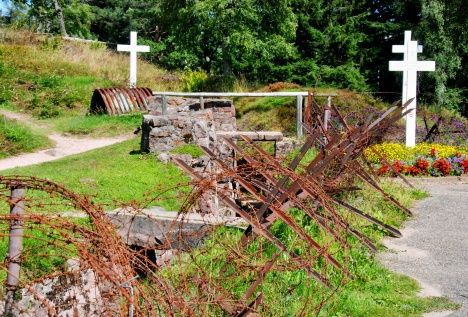
|
| Battlefield Linge% War Memorial (Photo: P. Züllig) |
You can't reduce Alsace to the old half-timbered houses, the good food, the excellent wine and the fascinating vineyards, there is more, much more, including a chequered history. And yet one is tempted to do it. People make pilgrimages to Alsace, from Germany, from Switzerland, from France, indeed from all over the world, to eat and drink well here. To sum it up in one sentence: Eating well and "drinking wine in beautiful places," Alsace ranks right up there.
On my trip, I did not completely renounce the culinary pleasure "in beautiful places". But for me - this one time - the landscape with its army of vines was far more important than food and drink. I wanted to be very close, to feel, to experience, to smell, to see how and where Alsatian wine has its roots. That's why I largely avoided visits to winemakers and tastings. The recently published book by Wolfgang Fassbender, "Alsace: Along the Wine Route (Wines, Winemakers, Sites, Specialties)" is an excellent documentation that I don't have to reinvent. However, the book has enticed me to explore, for once, not so much the wines as the landscape. I have already driven many thousands of kilometers of "wine roads" - in the most famous vineyards of the world, not only in Europe, but also in Australia, California, South Africa, and even China - but I have never experienced a more compact, fascinating vine panorama like here in Alsace.
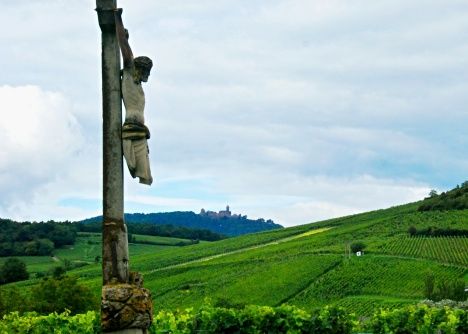
|
| Vines along the wine route. A similar picture presents itself over almost 100 kilometers% from wine village to wine village% from castle to castle. (Photo: P. Züllig) |
In the landscape, wine becomes concrete, wine is put back into nature, to where the grape juice came from. The few bright white letters in the most famous vineyards disturb more than they explain. At best, they remind us that wine quality is not only made and determined by people, but also by the sites, by nature, by what we often so uncharitably call "terroir". It is precisely because many villages in the midst of the vines look like oases from the Middle Ages, because industry has largely remained in the valley and has not eaten its way up the slopes, because historical awareness (and the tourist marketing of the idyll) has prevented all too great cultural damage, that the wine quality of the region is so important.e cultural damage, the wine region has remained a wine region and not become a wine production site (with huge cultivation areas and pompous cellars). One is and feels at home here with the wine.
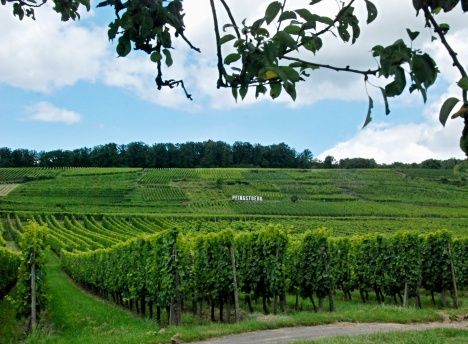
|
| Pfingstberg% Grand Cru site in Orschwihr with Riesling% Gewürztraminer and Pinot Gris (Photo: P. Züllig) |
"Wine from Alsace has never been as good as it is today. It would not only be a shame, it would be a big mistake to leave Alsace to the left. A voyage of discovery to Colmar or Guebwiller, to Ammerschwihr or Barr is worthwhile now more than ever" This is how Wolfgang Fassbender's wine book is advertised. It's true, but I don't know why it's worthwhile just "now more than ever". Because the wines have become better? Maybe, but the progress in viticulture and the increase in quality of wines can be seen worldwide. Because there is a danger that the dominant wine character in Alsace will gradually be lost, in favor of an exuberant culinary tourism? There are signs of this, traditional things are more and more becoming folklore, including wine. There is still a Renaissance fountain from which wine flows once a year instead of water (Fontaine du Vin in Ribeauvillé) - once, in many historic wine regions, this was an annual gift from the winegrowers to the poorer population - but no one wants to drink this "mass wine" anymore. The wine fountain has also become folklore.
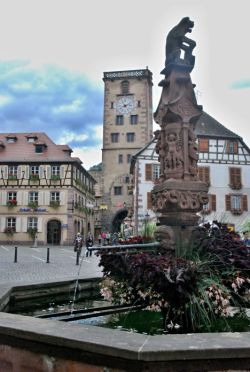
|
| Fontaine du Vin% the wine fountain in Ribeauvillé (Photo: P. Züllig) |
But something has remained genuine and original over all this time: the vines on the slopes and on the gentle hills, perhaps a little more well-tended, neater than they once were. They tower above the hustle and bustle of the busy villages, where you already have to look for the locals. The vineyards are witnesses to a culture that needs no folklore to be attractive. Perhaps the traditional image of the winegrower and the winegrowing businesses has been preserved so well (despite all the modernisation) precisely because the 15,000 hectares of vineyards are cultivated by more than 4,500 winegrowers, many of whom (well over half) own only two or even fewer hectares of vines. Although there are certainly larger operations, this extreme smallness is probably a guarantee of tradition and its preservation. Never have I stopped so often on a wine road, never have I walked so long through the rows of vines to take in the beauty of the well-tended cultivated countryside. This is more than agriculture, this is country culture.
Sincerely
Yours